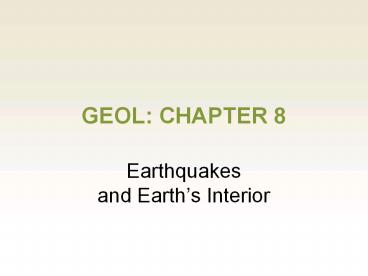GEOL: CHAPTER 8 - PowerPoint PPT Presentation
1 / 22
Title:
GEOL: CHAPTER 8
Description:
GEOL: CHAPTER 8 Earthquakes and Earth s Interior * Figure 8.22 Seismic Discontinuity Andrija Mohorovi i studied seismic waves and detected a seismic ... – PowerPoint PPT presentation
Number of Views:114
Avg rating:3.0/5.0
Title: GEOL: CHAPTER 8
1
GEOL CHAPTER 8
- Earthquakes and Earths Interior
2
Learning Outcomes
- LO1 Explain Elastic Rebound Theory
- LO2 Describe seismology
- LO3 Identify where earthquakes occur, and how
often - LO4 Identify different seismic waves
- LO5 Discuss how earthquakes are located
3
Learning Outcomes, cont.
- LO6 Explain how the strength of an earthquake is
measured - LO7 Describe the destructive effects of
earthquakes - LO8 Discuss earthquake prediction methods
- LO9 Discuss earthquake control methods
4
Learning Outcomes, cont.
- LO10 Describe Earth's interior
- LO11 Examine Earth's core
- LO12 Examine Earth's mantle
- LO13 Describe Earth's internal heat
- LO14 Examine earth's crust
5
Earths Interior
- Crust
- Mantle
- Outer core
- Inner core
6
(No Transcript)
7
Seismic Waves and Earths Interior
- P-wave and S-wave velocity determined by density
and elasticity of material - S-waves dont travel through liquids
- Seismic waves change velocity and direction when
enter material with different density or
elasticity (refraction)
8
Seismic Waves and Earths Interior, cont.
- Some waves are reflected
- Calculate depths of boundaries
- Discontinuity significant change in materials or
their properties
9
(No Transcript)
10
(No Transcript)
11
(No Transcript)
12
(No Transcript)
13
The Core
- P-wave velocity decreases at a depth of 2,900 km
core-mantle discontinuity - P-wave shadow zone
- Weak P-wave energy does penetrate the shadow
zone from solid inner core - S-wave shadow zone shows the outer core is
liquid, because S-waves cant travel through
liquids
14
(No Transcript)
15
(No Transcript)
16
(No Transcript)
17
Core Density and Composition
- 16.4 Earth volume
- 33 of mass
- Outer core 9.9 to 12.2 g/cm3
- Earth center pressure 3.5 million times of
surface - Outer core iron, sulfur, silicon, oxygen,
nickel, potassium - Inner core iron and nickel
18
Earths Mantle
- Moho discontinuity about 30 km deep
- Asthenosphere
- 100-250 km deep
- P- and S-waves slow down
- Plastic
- Magma generation
- Lithospheric plates ride across it
- 3.3 to 5.7 g/cm3 probably periodotite
19
(No Transcript)
20
Earths Internal Heat
- Geothermal gradient 25ºC/km
- Greater in active volcanic regions
- Most heat generated by radioactive decay
- Regions of equilibrium temperature
- Base of crust 800ºC to 1200ºC
- Core-mantle boundary 2,500ºC -5,000ºC
21
Continental Crust
- Granitic composition
- 2.5 to 3.0 g/cm3 average 2.7 g/cm3
- 20 to 90 km thick average 35 km thick
- Thickest under large mountain ranges
22
Oceanic Crust
- Gabbro overlain by basalt
- Average density 3.0 g/cm3
- 5-10 km thick
- Thinnest at spreading ridges































